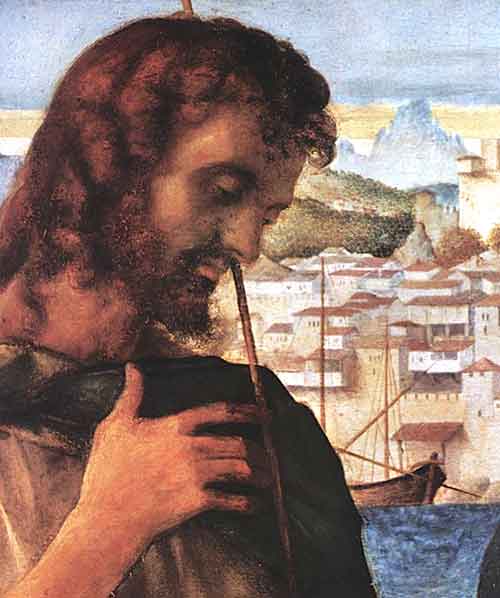
Let us pray (in silence) [that God’s coming casts light into our hearts]
Incline your ear, O Lord, [or Incline your ear, O God,]
to our pleading,
and by the grace of your coming to us
enlighten the darkness of our hearts,
through Jesus Christ, our Saviour,
who is alive with you,
in the unity of the Holy Spirit,
one God, now and for ever.
Amen.
This is part of my reworking collects with history and commentary.
This is a collect in the Gregorian Sacramentary (135). It is in the Sarum Missal as the collect for Advent 3, and remained in the Roman Rite in that position through to the 1962 Missal, only losing that placing following the reforms of Vatican II. This collect is:
Aurem tuam, quaesumus, Domine, precibus nostris accommoda:
et mentis nostrae tenebras, gratia tuae visitationis illustra…
This is a collect shared by Anglicans, Roman Catholics, and others. Advent 3 has John the Baptist as a strong thread, the one who was not the light, but came to testify to the light. We cannot of ourselves, darkness cannot of itself, eliminate darkness, but light shining, by the very act of shining, removes darkness.
Click the link for my commentary for the collect for Advent 3, or read below.
Advent 3 – reflection from the collect/opening prayer (used by BCP TEC and others)
Advent 3 – reflection from the collect/opening prayer (used by CofE Common Worship and others)
The Third Sunday of Advent is often referred to as Gaudete Sunday (colour Rose).
Remember: The Gloria (“Glory to God in the highest..”) is not used.
Don’t forget the Online Chapel with lots of resources of prayers and readings and reflections – many changing daily.
Other Resources
Original, Southern Hemisphere Advent collects
An outline example and resources for an Advent Eucharist
Advent in the Southern Hemisphere
Resources beyond this site:
Resources for Preaching Down Under
Textweek
Girardian Reflection
image: John the Baptist from Madonna and Child with St John the Baptist and a Saint by Giovanni Bellini (1500-1504)
In the comments below, please continue adding quality Advent resources and ideas.
If you appreciated this post, consider liking the liturgy facebook page, using the RSS feed, and/or signing up for a not-very-often email, …
Lectionary Readings Introductions
This site provides something different: many sites and books provide a brief summary of the reading – so that people read out or have in their pew sheet an outline of what they are about to hear. They are told beforehand what to expect. Does this not limit what they hear the Spirit address them? This site provides something different – often one cannot appreciate what is being read because there is no context provided. This site provides the context, the frame of the reading about to be heard. It could be used as an introduction, printed on a pew sheet (acknowledged, of course), or adapted in other ways. This is an experimental venture and I will see how useful it appears.
Isaiah 35:1-10
The context for this announcement is on the one hand the historical circumstances of the Isaiah’s eighth (to possibly early seventh) centure BC situation when the Northern Kingdom is annexed to the Assyrian empire with Judah living in its shadow as tributary, and on the other hand is the geographic assumption of arid places compared to fertile regions.
James 5:7-10
This letter is attributed to James the brother of the Lord. It includes seven exhortations contrasting negative with positive. Today’s reading follows the sixth negative section: arrogant planning and boasting, and the oppression of labourers and the just by the rich.
Matthew 11:2-11
Matthew 11:2-11

The context of today’s reading is the far- from-homogeneous messianic expectations of first century Palestine-Israel (there appears little independent evidence of a widespread expectation of a return of Elijah, for example). The text assumes an understanding of first century healing, of the Arundo donax (link off this site), the resilient, flexible, attractive, luxuriant grass that grows along the Jordan.
Image above: Arundo donax
Reflection on the Collect
This is a collect in the Gregorian Sacramentary (135). It is in the Sarum Missal as the collect for Advent 3, and remained in the Roman Rite in that position through to the 1962 Missal, only losing that placing following the reforms of Vatican II. This collect is:
Aurem tuam, quaesumus, Domine, precibus nostris accommoda:
et mentis nostrae tenebras, gratia tuae visitationis illustra…
There is now a similar collect in the Roman Rite on Monday of the Third Week of Advent:
Voci nostrae, quaesumus, Domine,
aures tuae pietati accomoda,
et cordis nostri tenebras
gratia Filii tui nos visitantis illustra.Incline a merciful ear to our cry, we pray, O Lord,
and, casting light on the darkness of our hearts,
visit us with the grace of your Son.
Who lives and reigns with you in the unity of the Holy Spirit,
one God, for ever and ever.
Cranmer translated Advent 3’s collect for the 1549 BCP as:
LORD, we beseche thee, geve eare to our prayers, and by thy gracious visitacion lighten the darkenes of our hearte, by our Lorde Jesus Christe.
For the 1662 revision it was replaced by a new, rather didactic collect written by John Cossin, Bishop of Durham, focusing on ordination which took place following this Ember week.
quaesumus… precibus is literally “we beseech… our prayers”. I think, for too many contemporary ears, that is overkill – I have combined the ideas into the strong “our pleading”.
mentis, mens, might literally be translated as “mind”, but can also refer to conscience, and so includes heart and soul, as well as mind. Hence, I have stayed with Cranmer’s rendering of that.
Visito is clearly connected to our English word, “vision”. Going to see someone is another way of saying that you will visit someone. But there is also an element of judgment – punishment is “visited” on someone. “Visitation”, to many contemporaries, will give the impression of coming for a short period and leaving again. Hence, my rendering as, “your coming to us”.
Advent 3, in contemporary lectionaries, has John the Baptist as a strong thread, the one who was not the light, but came to testify to the light. We cannot of ourselves, darkness cannot of itself, eliminate darkness, but light shining, by the very act of shining, removes darkness.


